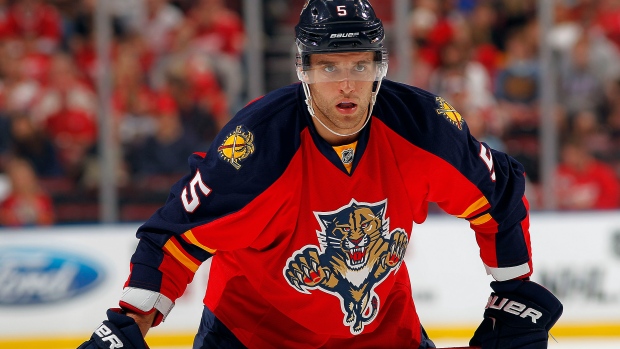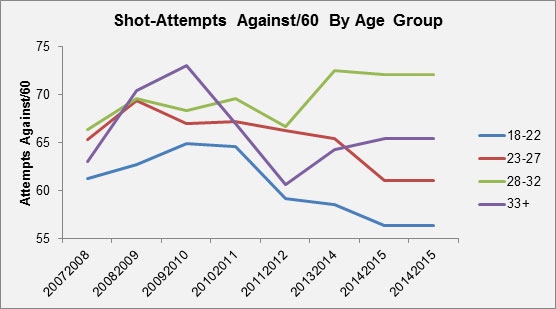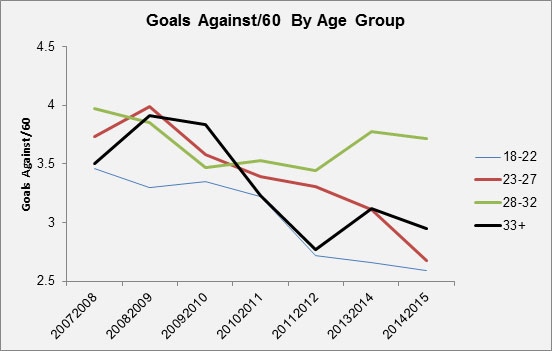Jul 21, 2015
Can young NHLers be trusted?
NHL veterans have a reputation as steady, reliable defensive options. Travis Yost examines the numbers to see whether or not younger NHL players can provide defensive value, maybe better than otherwise expected.
By Travis Yost

One of the hockey narratives I’ve always been curious about is the reputation that veterans pick up as the steady, reliable defensive options.
The reputation seems to be built out of the fact that these players have extensive experience at the NHL level, and through that experience, they have a built in advantage as it comes to deterring shots, scoring chances, and goals. They’ve seen every situation play out a thousand times over, and have a better feel for what to do – and what not to do – to keep the puck out of the back of their net. And, because they’re the ‘survivors’ of their draft classes, there is a very strong chance they are or were very sound players in their playing prime.
While I concede experience matters quite a bit, I get nervous about jumping to the conclusion that others sometimes do here. For one, the other side of the question is less frequently addressed. Younger players may not have the valuable experience, but the physical attributes – namely speed, agility, power, and stamina – should factor in here, especially from a defensive perspective. The veteran hockey player may know where to be, but he may not always get there. The young player may not always know where to be, but he can get to that spot in a cinch.
There’s been interesting work in the past on peak performance by age in the past – perhaps the simplest and most notable came from Gabe Desjardins, who showed that peak scoring age (for one example) is just about 25-years. Eric Tulsky looked into the relationship between aging and power-play ability, and found the aging curve to be much more kind.
Which brings us back to the purported veteran/defensive skill relationship noted above. Out of sheer curiosity, I have binned all regular even-strength hockey players by season (lockout year omitted) and age (18-22,“Early”; 23-27 ,“Early Prime”; 28-32 ,“Late Prime”; and 33+. “Late”). Then, I pulled their suppression stats, including shot attempts against per-60 and goals against per-60.
How does each group fare? First, let’s look at shot suppression.

The takeaway here should be obvious – no age-group has suppressed shots better than our 18-22 year-olds, guys truly limited on experience but likely in possession of those critical physical skills that get the job done against the most talented players in the world. Our ‘Early Prime’ guys look pretty strong here too – you can bet they’re playing a bigger slice of minutes against tough competition, but you can also bet they are slotted higher up in the lineup with higher quality teammates. The 28-32 and 33+ groups pull up the rear, conceding shots at a higher rate than the others.
That’s half of the analysis. We also need to look at goals. Do they fall in line with what we are seeing in the shot department, or is there deviation?

Again, not particularly close – the 18-22 age group suppresses goals better than any other age group. The 23-27 and 33+ age groups look pretty interchangeable here, with the 28-32 group bringing up the rear. Personally I find this graph even more telling than the last one, especially with how much we hear and see coaches unwilling to trust their young players in high-leverage defensive minutes.
I’ll conclude with a couple of final thoughts.
One, this isn’t a smoking gun conclusion. It is, however, an interesting rebuttal to the theory that experience pays higher dividends than youth on the defensive end. The data certainly doesn’t support that conclusion.
Two, I’m not sure this means that more 18-22 year olds should be trusted. A lot of players that age are sitting in junior, NCAA, or the AHL because they’re not ready for this level of competition, and for good reason. The players who are getting the NHL minutes generally are physical specimens and/or so finely skilled that they’ve been blasting inferior competition for quite some time. Truthfully, it shouldn’t be surprising that they’re more than adequate defenders, even in their young age.
Three, the players who are in that 18-22 age group and getting NHL ice-time? Perhaps they should be trusted a bit more. The data does support that conclusion, anyway.



